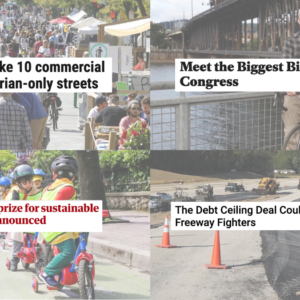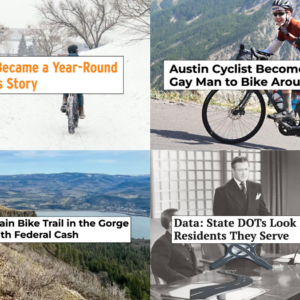
This week’s Monday Roundup is brought to you by Hassalo on Eighth, Portland’s newest bike-friendly community.
Here are the bike links from around the world that caught our eyes this week:
Bike-path murals: Montréal may allow them.
Bikes and disability: In London, about 15 percent of people with disabilities bike for transportation compared to 18 percent of people without disabilities, observes wheelchair handcyclist Isabelle Clement.
New York City’s Pulaski Bridge between Queens and Brooklyn has a “magnificent” new protected bike lane.
Tokenism in advocacy: “Sometimes we have to tokenize ourselves for the sake of pushing the movement forward,” said Los Angeles Bicycle Coalition Executive Director Tamika Butler. It’s the prompt for an uncomfortable, interesting piece about race in the biking movement.
“Interesting outriggers”: Seattle is voting on a ballot measure that would preserve or rebuild its allegedly architecturally significant Harbor Viaduct for elevated park space.
Drinking while driving: It’s still legal in Mississippi.
Road rules: After an advocacy campaign, Idaho’s driving test now asks about people biking and walking.
Bike-share equity: “Most bike-share systems are too small to provide useful transportation options,” writes NACTO’s bike-share expert.
Manufactured consent: CNN viewers see five times as much advertising by the oil industry as they do reporting on climate change.
Freeway bottleneck: Texas has cut congestion on State Route 161 by turning the shoulder of a two-lane bottleneck between two three-way stretches into a traffic lane, but some predict gains will be temporary as traffic expands to fill the demand.
Auto lobby: Google, Ford, Uber, Lyft and Volvo have teamed up to create the Self-Driving Coalition for Safer Streets, the first lobby group for self-driving cars.
Roof racks: Aerodynamic drag from roof racks might be responsible for 1 percent of all national fuel consumption by cars and SUVs. (The other 99 percent: yep, it’s the cars and SUVs.)
Advertisement
Frankentrike: It’s electric-assisted, hauls 500 pounds of cargo, gets 900 miles to the gallon-equivalent and is currently fundraising on Indiegogo.
Vision Zero: The growing movement to aim for zero traffic deaths draws coverage in Fortune magazine.
Measuring urbanism: Portland-based City Observatory has created a “Storefront Index” that measures the vibrancy of an area by number and concentration of commercial shops. (Portland’s downtown ranks 10th nationally in a virtual tie with Seattle.)
Measuring walking: Walk Score measures walkability of a location by the variety of destination types within walking distance. Portland’s rose in 2016, but not as fast as others like St. Louis or Los Angeles, which now top us; we’re 16th.
Mountain biking: After three years’ advocacy, a new 4.5-mile trail is the start of a planned system at Silver Falls State Park near Salem.
Parking: With many competing needs on major streets, “San Francisco Needs to Get Out of the Car Storage Business,” writes Streetsblog SF.
Study tour: Mayor Charlie Hales was in Copenhagen last week, riding bikes with U.S. Transportation Secretary Anthony Foxx and the Danish Cycling Embassy.
Root causes: The problem with texting while driving isn’t actually the texting, notes FastCoExist. It’s the driving.
Montana crowdfunding: Missoula’s nonprofit bike shop is looking to buy the land it operates on.
Car-free Champs-Élysées: Starting on Sunday, the most famous street in the world will be pedestrian-only one day a month.
If you come across a noteworthy bicycle story, send it in via email, Tweet @bikeportland, or whatever else and we’ll consider adding it to next Monday’s roundup.
— Michael Andersen, (503) 333-7824 – michael@bikeportland.org
Our work is supported by subscribers. Please become one today.





Thanks for reading.
BikePortland has served this community with independent community journalism since 2005. We rely on subscriptions from readers like you to survive. Your financial support is vital in keeping this valuable resource alive and well.
Please subscribe today to strengthen and expand our work.
Tokenism in Advocacy: Most of the bicyclists on Greensboro’s streets are people of color, yet not unlike Portland, most community bike advocates, city planners, and transportation engineers are overwhelmingly white. My guess of the reason for this is a justified strong distrust of government by the African American and non-European immigrant communities.
Measuring Urbanism: In the case of Greensboro (and probably most other cities), the storefront index seems to include strip malls and some apartment buildings in their index as pluses. This is also true of East Portland, which has traditional storefront commercial only along NE Halsey/Weidler between 102nd and 112th; the rest is strip malls and off-street commercial, but is listed on the index maps as storefront commercial. This index is more about how much commercial is along main streets, as opposed to indoor shopping malls.
5 thumbs up for the root causes link ( cars not texting). I have thought this all along. Though both texting while driving and drinking while driving are horrible, dangerous behaviors that deserve the condemnation and penalties that they get ( or don’t get) focusing on them distracts us from the real problem that having people hurtling over the earth at high speeds in multi-ton metal boxes passing within inches of each other and pedestrians and cyclists is insane. An alien who came to earth from a sane and more advanced civilization would be horrified if they took one look at our automobile transportation system from a safety point alone.
I have no argument with the fact that the more driving takes place the more roadway CARnage we will see. However, heartless as it may seem, I don’t really care about motorist on motorist violence. I’m concerned with motorist on VRU violence. Of course a graph of roadway deaths vs miles driven will show a correlation. However, how about the number of VRU deaths? Are those more closely correlated with miles driven or with driving hours of cell phone use? Unfortunately, we don’t have numbers for the hours of cell phone use while driving.
Take a look at what people do when they are playing with their vibrators while driving. They tend to stay well to the right in order to avoid oncoming and adjacent motor vehicles. Guess who’s over there at the right side? Also, on those many roads where one must take the lane, folks often only look up from their toys long enough to notice if there is a car in front of them; we don’t register.
Driving kills and maims. Texting or driving while intoxicated kills and maims more often per hour of activity.
48in wide trike seems stable, if a bit wide.
too wide to go over the I-5 bridge path…
Regarding the article about Mississippians being allowed to drink and drive: I recall the late (great) Molly Ivins commenting that God made Mississippi so that Texas didn’t have to be last in everything.
I was down in the Dallas suburbs last week and saw some of those median lanes. For whatever reason, they were relatively empty compared to other lanes.
As miserable as I was having to drive, I would still rather drive the Bush Turnpike (and surrounding areas) than any road in Portland. I continue to question why anyone who drives everywhere they go would choose to live in Portland.
As the late Phil Ochs sang, “Mississippi find yourself another country to be part of.”
Just based on the photo in the article, I’d hate to ride on a bike lane with a Mural on it. It could make an object in the lane hard to see – a significant safety hazard.
It’s great that Idaho has included cycling questions in their drivers test. I noticed one mistake though in the Idaho Transportation Department online quiz. It includes the figure from the infamous bogus 1989 study about cycle helmet effectiveness. They have 85% down as the “correct” answer. (In fact none of other choices in the multiple choice question is accurate either.)
Anyone who’s studied this knows this to not be true so it’s surprising and sad that this lie is still out their being repeated.
The Seattle Viaduct article is ~8 months old.